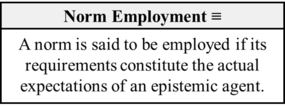Norm Employment
What is norm employment? How should it be defined?
If it is assumed that normative theories of all types have the capacity of being employed, then it is important to define the term norm employment.
In the scientonomic context, this term was first used by Hakob Barseghyan in 2018. The term is currently accepted by Scientonomy community.
In Scientonomy, the accepted definition of the term is:
- A norm is said to be employed if its requirements constitute the actual expectations of an epistemic agent.
Scientonomic History
Acceptance Record of the Term
| Community | Accepted From | Acceptance Indicators | Still Accepted | Accepted Until | Rejection Indicators |
|---|---|---|---|---|---|
| Scientonomy | 1 September 2019 | The question became accepted as a result of the acceptance of the first definition of the term. | Yes |
All Definitions
| Theory | Formulation | Formulated In |
|---|---|---|
| Norm Employment (Barseghyan-2018) | A norm is said to be employed if its requirements constitute the actual expectations of an epistemic agent. | 2018 |
Accepted Definitions
| Community | Theory | Formulation | Accepted From | Accepted Until |
|---|---|---|---|---|
| Scientonomy | Norm Employment (Barseghyan-2018) | A norm is said to be employed if its requirements constitute the actual expectations of an epistemic agent. | 1 September 2019 |
Suggested Modifications
| Modification | Community | Date Suggested | Summary | Date Assessed | Verdict | Verdict Rationale |
|---|---|---|---|---|---|---|
| Sciento-2018-0008 | Scientonomy | 8 October 2018 | Accept the definition of norm employment. | 1 September 2019 | Accepted | The consensus on this modification emerged mostly off-line.c1 Importantly, it was also emphasized that its acceptance may have a ripple effect on other accepted definitions.c2 It was not clear whether "the acceptance of a new theory could be considered to implicitly grant permission to the editors to make small changes to old theories for the sake of maintaining consistency, without the need for explicit review and acceptance".c3 Thus, a new question concerning handling this ripple effect was accepted. |
Current Definition
In Scientonomy, the accepted definition of the term is Norm Employment (Barseghyan-2018).
Norm Employment (Barseghyan-2018) states: "A norm is said to be employed if its requirements constitute the actual expectations of an epistemic agent."
This definition is meant to ensure that the notion of employment is applicable not only to methods but to norms of all types, as is the case in the ontology of epistemic elements suggested by Barseghyan in 2018. According to that ontology, the capacity of being employed can be ascribed not only to norms of theory evaluation (i.e. methods), but to norms of all types, including ethical norm and aesthetic norms.1
Ontology
Existence
In Scientonomy, it is currently accepted that "There is such a thing as norm employment."
Subtypes
In Scientonomy, there are currently no accepted subtypes of Norm Employment.
Supertypes
In Scientonomy, the following supertype of Norm Employment is currently accepted:
Associations
In Scientonomy, there are currently no accepted associations of Norm Employment.
Disjointness
In Scientonomy, no classes are currently accepted as disjoint with Norm Employment.
If a question concerning the ontology of norm employment is missing, please add it here.
Dynamics
Mechanism of Method Employment
In Scientonomy, the accepted answer to the question is:
- A method becomes employed only if it is derivable from a non-empty subset of other elements of the mosaic.
Mechanism of Norm Employment
In Scientonomy, the accepted answer to the question is:
- A norm becomes employed only if it is derivable from a non-empty subset of other elements of the mosaic.
If a question concerning the dynamics of norm employment is missing, please add it here.
Related Topics
This term is also related to the following topic(s):
References
- ^ Barseghyan, Hakob. (2018) Redrafting the Ontology of Scientific Change. Scientonomy 2, 13-38. Retrieved from https://scientojournal.com/index.php/scientonomy/article/view/31032.
